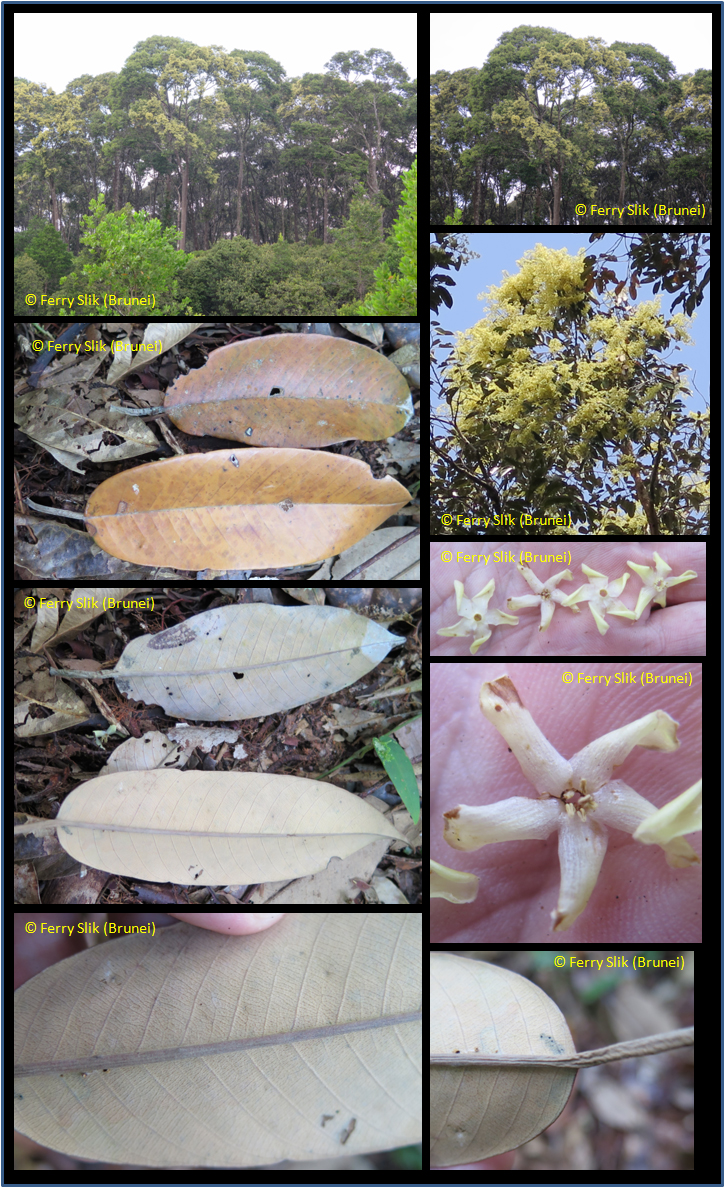Shorea albida Symington ex Thomas, Gard. Bull. Straits Settlem. 8: 283 (1935)
Name meaning 'pale or white', referring to the lower leaf surface.Synonyms
Diagnostics
Large tree up to 40 m tall, buttressed. Gregarious in peat swamp forest. Stipules present.
Leaves alternate, thick leathery, pale-yellowish beneath, with close venation and long petiole.
Flowers in branched inflorescences, ca. 2 cm diameter, pale-yellow, petals overlapping. Fruit a
winged nut, with three long wings of up to 8 cm length. Nut ca. 1.2 cm diameter.
Description
Small, medium-sized or vast buttressed tree. Twig,
leaf bud, stipule, petiole and leaf nervation beneath
shortly densely persistently red-brown puberulent;
leaf beneath cream lepidote. Twig to 5 by 2 mm
apically, compressed, becoming smooth; stipule scars
short, straight, thin. Bud to 10 by 6 mm, ovoid to
hastate, compressed, acute. Stipules to 20 by 8 mm,
oblong, obtuse. Leaves 7.5-15 by 4.5-6.5 cm, oblongelliptic,
coriaceous; base obtuse; acumen to 6 mm
long, broad; nerves 16-20 pairs, slender, hardly raised
beneath, at 55-70 degrees, with shorter intermediates; tertiary
nerves slender, densely scalariform, diagonal to
nerves; midrib prominent beneath, obscure and
depressed above; petiole 2-3.5 cm long. Panicle to 18
cm long, terminal or axillary, compressed, shortly
densely cream puberulent; doubly branched, branchlets
bearing to 3 flowers; bracteoles to 8 by 3 mm,
lanceolate, acute, densely pubescent outside, glabrous
within. Bud to 9 by 5 mm, broadly ellipsoid, acute.
Calyx densely puberulent outside, glabrous within; 3
outer lobes deltoid, obtuse; 2 inner shorter, deltoid,
acuminate. Petals cream, ovate, obtuse, pubescent on
parts exposed in bud. Stamens 20-25, of variable
length, the inner 5 somewhat longer than the others;
filament broad at base, tapering and filiform distally;
anther narrowly oblong, longer than the filament;
appendage to connective short, slender, erect, less
than 0.5 the length of anther. Ovary ovoid, shortly pubescent;
style twice length of ovary, densely pubescent in
basal half. Fruit calyx persistently sparsely pubescent
at base, glabrescent elsewhere; 3 longer lobes to 8 by
1.4 cm, narrowly spatulate, obtuse, to 4 mm broad
above the to 7 by 7 mm suborbicular thickened saccate
base. Nut to 12 by 9 mm, ovoid, densely greyish buff
pubescent; style remnant to 2 mm long. [from Flora Malesiana]
Ecology
Local on podsols on terraces and plateaux in Heath forest to 1200 m. Gregarious and dominant on
oligotrophic peat swamps except at the margin and sometimes centre.
The peat swamp forests where S. albida occurs can be classified into a succession of
concentric "phasic' communities according to the performance of this and
other dominant species. 1. A mixed species forest at the periphery lacking S. albida.
2. With S. albida dominant and sometimes reaching 6.5 m tall, but forming an incomplete
heterogeneous canopy and rarely successfully regenerating. 3. With S. albida forming a
complete even canopy, regenerating patchily and becoming smaller towards the centre.
4. With Litsea palustris a dominant or codominant, forming an even canopy but not exceeding
40 m tall. Here regeneration is abundant though largely through coppicing.
S. albida does not occur in the innermost communities. Lightning and wind damage form conspicuous
gaps in the even canopy of phasic community, but mortality over much greater
areas, in large sharply defined patches totalling thousands of hectares in all, is attributed
to an unidentified moth larva, belonging to the Himantidae.
Uses
The largest trees, towards the margins of the swamps, are all hollow and are very hard wooded;
those towards the centre are too small and the wood is soft; trees in the intermediate zone are
an important source of red meranti timber.
Distribution
Borneo (only northern).
Local names
Borneo: Alan (Sarawak), Seringawan (Brunei).
